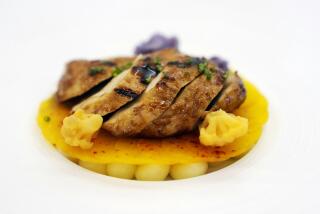U.S. Scientists Debut Gene, a Calf Cloned From a Fetus
- Share via
DeFOREST, Wis. — Scientists unveiled a 6-month-old cloned calf Thursday, describing it as a step toward yielding beefier steers and milkier cows, as well as new medicines and perhaps transplant organs for people.
The black-and-white Holstein named Gene, which chewed its cud and licked a man’s hand as photographers crowded around its pen, was made in a different way than Dolly, the sheep cloned last year by Scottish researchers.
While Dolly was produced from the udder cell of a 6-year-old ewe, Gene’s genes originated in a cell from a 30-day-old fetus. Because the bovine genes hadn’t developed specific functions the way most adult cells have, they were more amenable to producing an entirely new creature, said Neil First, a professor of animal science at the University of Wisconsin at Madison.
It took at least 150 attempts and an investment of about $15 million since 1987 before ABS Global Inc. scientists successfully cloned Gene, said Marc van’t Noordende, the biotechnology company’s president and chief executive.
In fact, Gene already has two fellow clones: Gene Two and Gene Three, company officials said.
“We can make an unlimited number of cells, freeze them for any amount of time, then thaw them and make identical animals possessing a desired trait,” said Dr. Michael D. Bishop, vice president of research. “Cells from cattle containing unique, favorable traits can be stored indefinitely, essentially preserving them for the future.”
In cloning an animal, scientists can also turn it into a living factory by sticking an extra gene into the egg that codes for some desired substance. Then the animal’s milk would have the substance in it.
Van’t Noordende said it would be several years before the first products resulting from the process would be introduced. Cloned cattle would be useful in agriculture because they could be genetically manipulated to produce more milk or beef. They also have the potential to be used for organs that humans need for transplants. The genes in an animal could be manipulated so humans won’t reject the organ, van’t Noordende said.
More to Read
Sign up for Essential California
The most important California stories and recommendations in your inbox every morning.
You may occasionally receive promotional content from the Los Angeles Times.










